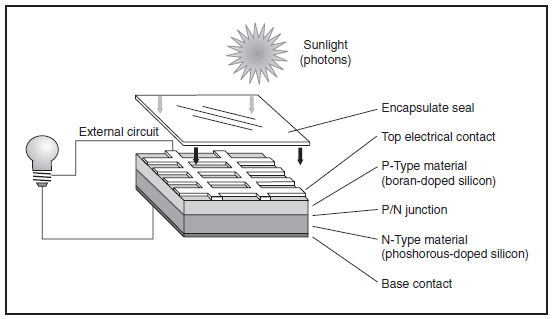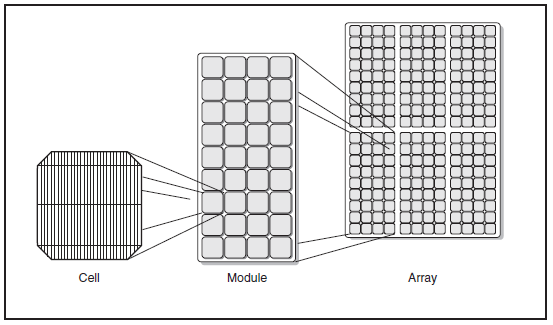Introduction to Photovoltaic Systems
INTRODUCTION
Photovoltaics offer consumers the ability to generate electricity in a clean, quiet and reliable way. Photovoltaic systems are comprised of photovoltaic cells, devices that convert light energy directly into electricity. Because the source of light is usually the sun, they are often called solar cells. The word photovoltaic comes from "photo," meaning light, and "voltaic," which refers to producing electricity. Therefore, the photovoltaic process is "producing electricity directly from sunlight." Photovoltaics are often referred to as PV.
PV systems are being installed by Texans who already have grid-supplied electricity but want to begin to live more independently or who are concerned about the environment. For some applications where small amounts of electricity are required, like emergency call boxes, PV systems are often cost justified even when grid electricity is not very far away. When applications require larger amounts of electricity and are located away from existing power lines, photovoltaic systems can in many cases offer the least expensive, most viable option.
In use today on street lights, gate openers and other low power tasks, photovoltaics are gaining popularity in Texas and around the world as their price declines and efficiency increases.
HOW IT WORKS
PV cells convert sunlight directly into electricity without creating any air or water pollution. PV cells are made of at least two layers of semiconductor material. One layer has a positive charge, the other negative. When light enters the cell, some of the photons from the light are absorbed by the semiconductor atoms, freeing electrons from the cell's negative layer to flow through an external circuit and back into the positive layer. This flow of electrons produces electric current.
To increase their utility, dozens of individual PV cells are interconnected together in a sealed, weatherproof package called a module. When two modules are wired together in series, their voltage is doubled while the current stays constant. When two modules are wired in parallel, their current is doubled while the voltage stays constant. To achieve the desired voltage and current, modules are wired in series and parallel into what is called a PV array. The flexibility of the modular PV system allows designers to create solar power systems that can meet a wide variety of electrical needs, no matter how large or small.

|
| Basic solar cell construction The sandwich of semiconductor materials produce electricity directly from the sunlight without any moving parts. |

|
| Photovoltaic cells, modules and arrays The building blocks of solar electricity are modular in nature, allowing great flexibility in applications. |
THE GRID: ON OR OFF?
Some homeowners in Texas are turning to PV as a clean and reliable energy source even though it is often more expensive than power available from their electric utility. These homeowners can supplement their energy needs with electricity from their local utility when their PV system is not supplying enough energy (at nighttime and on cloudy days) and can export excess electricity back to their local utility when their PV system is generating more energy than is needed.
For locations that are "off the grid" - meaning they are far from, or do not use, existing power lines - PV systems can be used to power water pumps, electric fences or even an entire household.
While PV systems may require a substantial investment, they can be cheaper than paying the costs associated with extending the electric utility grid. A consumer in Texas may be asked to pay anywhere from $5,000 to $30,000 per mile to extend power lines.
THE RIGHT EQUIPMENT FOR THE JOB
A grid-connected PV system will require a utility interactive DC to AC inverter. This device will convert the direct current (DC) electricity produced by the PV array into alternating current (AC) electricity typically required for loads such as radios, televisions and refrigerators. Utility interactive inverters also have built-in safety features required by electric utilities nationwide.
For an off-grid PV system, consumers should consider whether they want to use the direct current (DC) from the PV's or convert the power into alternating current (AC). Appliances and lights for AC are much more common and are generally cheaper, but the conversion of DC power into AC can consume up to 20 percent of all the power produced by the PV system.
To store electricity from PV's, batteries will be needed. The batteries used for PV systems are different from car batteries. The batteries best suited for use with PV systems are called secondary or deep cycle batteries. There are two types of deep cycle batteries: lead acid, which require the periodic addition of water, and captive electrolyte (or gelcell) batteries, which are maintenance free.
In addition, PV systems require proper wiring, switches and fuses for safety, controllers to prevent the batteries from being overcharged or overly discharged, diodes to allow current to flow in the right direction, and grounding mechanisms to protect against lightning strikes.

|
| Components of a typical off-grid PV system Solar electricity can be used for many purposes, either directly, or by storing in batteries for use when the sun is not shining. |
InfinitePower.org | Financial Acknowledgement This publication was developed as part of the Renewable Energy Demonstration Program and was funded 100% with oil overcharge funds from the Exxon settlement as provided by the Texas State Energy Conservation Office and the U.S. Department of Energy. Mention of trade names or commercial products does not constitute endorsement or recommendation for use. |
ORGANIZATIONS
American Solar Energy Society
2400 Central Ave., G-1
Boulder, CO 80301
(303) 443-3130
www.ases.org
Great list of publications
Texas Solar Energy Society
P.O. Box 1447
Austin, TX 78767-1447
(512) 326-3391 or (800) 465-5049
e-mail: info@txses.org
www.txses.org
Solar goings on in Texas
Solar Energy International
P.O. Box 715
Carbondale, CO 81623-0715
(970) 963-8855
www.solarenergy.org
Info on PV design, installation workshops
Solar Energy Industries Association
1616 H Street, NW 8th Floor
Washington, DC 20006 (202) 628-7979
(301) 951-3231
www.seia.org
Comprehensive list of PV manufacturers
Texas Renewable Energy Industries
Association
Box 16469
Austin, TX 78761
(512) 345-5446
www2.treia.org/treia/
Comprehensive list of PV suppliers and installers
RESOURCES
FREE TEXAS RENEWABLE ENERGY INFORMATION
For more information on how you can put Texas' abundant renewable energy resources to use in your home or business, visit our website at www.InifinitePower.org or call us at 1-800-531-5441 ext 31796. Ask about our free lesson plans and videos available to teachers and home schoolers.
ON THE WORLD WIDE WEB:
Center for Renewable Energy and Sustainable Technology (CREST)
This site has a comprehensive list of related web sites.solstice.crest.org
Florida Solar Energy Center. Information on photovoltaics, batteries, alternative buildings systems, solar heaters. FSEC offers training courses such as, "Installation of Grid-Connected Photovoltaic Systems." www.fsec.ucf.edu
Real Goods. Site offers introductory explanations of solar technologies. You can buy a wide variety of solar goods, PV modules, compact fluorescent bulbs and other gear. A worthy stop for anyone shopping for solar-powered or energy efficient items.www.realgoods.com
Department of Energy. Web pages run by the Department of Energy. This site has a much more detailed fact sheet on PV basics. www.eren.doe.gov/erec/factsheets/pvbasics.html
Sandia National Laboratory Photovoltaic Program. This site offers descriptions of a variety of PV systems. This rich site also includes system sizing worksheets, PV codes and standards, and PV economics.www.sandia.gov/pv/
Department of Energy' Photovoltaic Program
This web site contains a comprehensive directory of U.S. organizations involved in PV. www.eren.doe.gov/pv/pvdirectory.html
BOOK:
Just Add Sunshine, Solar Electricity Will Set You Free. J. Michael Mooney, ARC Press of Cane Hill, 1997. A self study guidebook on the exciting world of solar electricity. Detailed examples of PV systems to power both large and small dwellings are included. (Available at 1-800-340-8242)

